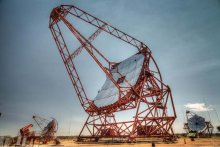First detection of gamma-ray burst afterglow in very-high-energy gamma light
After ten years of effort, a collaboration of scientists, including LAPP, observed for the first time the emission of very high energy from a gamma-ray burst. This discovery was made in July 2018 by the huge 28-m telescope of the H.E.S.S. array in Namibia.. This gamma-ray burst, an extremely energetic flash produced following a cosmic cataclysm, emitted very high energy gamma rays for several hours after the initial explosion.
Extremely energetic cosmic explosions generate gamma-ray bursts (GRB), typically lasting for only a few tens of seconds. The burst is followed by a longer lasting afterglow in the optical and X-ray spectral regions whose intensity decreases rapidly.
On 20 July 2018, the Fermi Gamma-Ray Burst Monitor and a few seconds later the Swift Burst Alert Telescope notified the world of a gamma-ray burst, GRB 180720B. Immediately after the alert, several observatories turned to look at this position in the sky.In the aftermath of this alert, several ground-based observatories immediately pointed in the direction of the gamma-ray burst. For H.E.S.S. (High Energy Stereoscopic System), this location became visible only 10 hours later. Nevertheless, the H.E.S.S. team decided to observe this position in order to look for a possible emission during the residual phase of the start. After more than ten years of seeking a signature for these very high-energy cataclysms, the collaboration has seen its efforts bear fruit.
The data collected over two hours, between ten and twelve hours after the start, revealed a new source of gamma emission, point source, coinciding with the start. While the detection of very high energy gamma emission from a start was quite widely anticipated, the fact that this emission continues for hours after the initial start, during the afterglow phase, was a real surprise. The discovery of the first gamma-ray burst detected at such energies is announced in a publication of the H.E.S.S. collaboration in Nature magazine today.
This burst was detected by the largest of the five telescopes in the HESS network, of which the LAPP built the camera’s landing system. “The measurement was made at the limit of the instrument’s sensitivity,” explains Armand Fiasson, a physicist at the LAPP, “so we had to work very carefully on the analysis to be sure that it was not just a simple fluctuation in background noise. A work mainly carried out by Quentin Piel, a thesis student at the LAPP in collaboration with Edna Velasco, a thesis student at Heidelberg. “Since 2016, thanks in particular to the funding of a post-doc and a thesis by the labEx Enigmass, the LAPP group has been very active in this data analysis work in order to set up an increasingly effective methodology,” explains Gilles Maurin, physicist in charge of the HESS group at the LAPP.
GRB 180720B was very strong and lasted for about 50 seconds – a relatively long duration indicating the death of a massive star. In this process, its core collapses to a rapidly rotating black hole. The surrounding gas forms an accretion disk around the black hole, with gas jets ejected perpendicularly to the disk plane creating the gamma-ray flashes.
The very-high-energy gamma radiation which has now been detected not only demonstrates the presence of extremely accelerated particles, but also shows that these particles still exist or are created a long time after the explosion. Most probably, the shock wave of the explosion acts here as the cosmic accelerator. Before this H.E.S.S. observation, it had been assumed that such bursts likely are observable only within the first seconds and minutes at these extreme energies.
“It’s great to have done this detection with HESS,” Armand enthuses, “and it’s all the more encouraging for future observations as part of the Cerenkov Telescopes Array project, a network of telescopes designed to be both faster and more sensitive. With the new insights provided by this major discovery, ever fine-tuning analytical methods and improving technologies, we expect to detect a large number of very high energy gamma-ray bursts, and a much more detailed understanding of this phenomenon.”
Photo : The large central H.E.S.S. telescope with 614 m² mirror area and two of the four smaller telescopes, each with 107 m² mirror area. ©Mathieu de Naurois / IN2P3
Contact : Dr Armand Fiasson Phone : +33 4 50 09 16 70 E-mail : armand.fiasson@lapp.in2p3.fr


